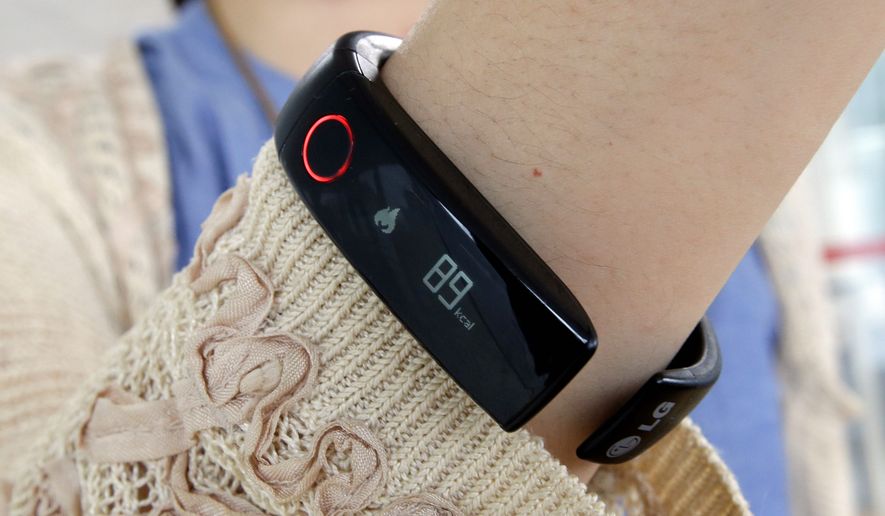The technology behind wearable electronics finally may have arrived, but whether consumers will greet it with open wallets is another question.
Smartwatches, fitness trackers, iGlasses, goggles and even “smart” diapers are among the many wearable electronics products already available to consumers, but analysts and researchers say it’s too early to determine whether the gadgets will transform the marketplace.
Overall patent publication of wearable electronics, which are integrated into clothing and wearable accessories, has been growing at a 40 percent annual rate since 2010, with 41,301 patents published from 2010 through May 2015, according to a report released this week by Boston-based Lux Research.
Leading the pack is Samsung Electronics, followed by Qualcomm Inc. and Apple Inc. Market watchers say Samsung is trying to take advantage of a burgeoning technological market with wider consumer interest in the years to come.
“First, moving into wearable electronics agrees with the general interest of using electronic devices to better understand oneself in a quantitative way,” Lux research analyst Tony Sun said in an email. “Second, Samsung is a major consumer electronic device and component developer. Wearable devices, like smartwatches, are a natural fit for Samsung’s existing manufacturing capability, technology portfolio as well as customer base.”
Analysts also say increased patent production could be a sign that developers are looking to transform the wearable technology industry.
“We already saw companies like Apple roll out their own smartwatches. Beyond traditional electronics companies, we also see a lot of innovation coming from medical device companies like Philips, as well as IT companies like Google,” Mr. Sun said.
One of the most successful gadgets on the market has been Fitbit, a variation on the smartwatch that allows people to track their health as they work out. Even President Obama was spotted wearing one.
Shares for Fitbit Inc. surged over 48 percent on its first day of trading last month, reflecting high investor appetite. Its sales tripled last year, leading the fitness-tracking industry that is itself expected to triple devices sold by 2018, according to a report last year by Juniper Research, a mobile, online and digital research firm.
But even as developers such as Fitbit seize niches in the wearable technology market, analysts say, the next-biggest obstacle is getting people to buy fuller lines of products.
“They are not really being widely used,” said Mr. Sun. “It takes time for technology to become marketable technology. One key reason is that developers have not developed a killer application for wearables. Most current wearables are working as extensions of the smartphones and still need to rely on smartphones to realize some functions.”
The consumer market may be only a part of the wearable technology wave. Managers in Singapore have been experimenting with smart bracelets to keep track of widely dispersed employees (raising privacy concerns along the way), and those working with autistic children and others with developmental or emotional problems are using hug- and pressure-producing garments to calm troubled patients.
Companies are working on tooth-embedded sensors to help dentists track patients’ diets, and “smart diapers” can discover health issues for babies and let parents know via smartphone. Parents can scan a code placed in the diaper to check for urinary tract infections, dehydration and other health issues.
There is also evidence that the more manufacturers can pile on wearable technology, the more consumers approve.
Consumer monitoring firm J.D. Power & Associates this week issued its first “Fitness Brand Device Satisfaction” survey and found that smartwatches and fitness tracker bands scored a healthy 839 out of 1,000 on its scale, and the more complex offerings pleased their owners more. The AppleWatch was released just before the survey and was not rated.
“As you go up the technology ladder, and as devices become more complex, satisfaction rises,” J.D. Power Senior Director Kirk Parsons told Marketing Daily.com. “The more features and services you have, the more satisfaction you’re going to get.”
But he also warned that consumer standards and expectations will rise as the novelty of the technology wears off.
“As people get used to smartwatches [and] what they can and can’t get out of them, you’ll see more complaints about the technology,” Mr. Parsons said.
Another challenge for developers has been the expense of wearable electronics, analysts say. According to a 2014 survey of nearly 4,000 adults, 70 percent are aware of wearable devices, but only 15 percent use one. The Nielsen Connected Life Report also found that 72 percent of users want the wearables to be less expensive.
But in an industry that is just beginning to bloom, where developing the products can be expensive, companies are looking at other alternatives to emerge as big players in the market.
“We believe the next big dividing line in wearables will be around size and wearability,” said Mimi Huggins, a spokeswoman for Jawbone, a San Francisco-based wearable tech products company. “While some manufacturers are happy to load their devices with features, perhaps to the detriment of size and comfort, our wearables are designed to be small, comfortable and worn 24/7.”
• Brennan Weiss can be reached at bweiss@washingtontimes.com.




Please read our comment policy before commenting.